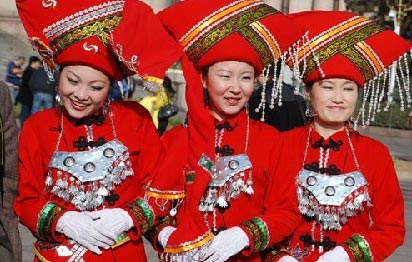The Zhuang ethnic group

Culture
The Zhuang language belongs to the Chinese-Tibetan language family. Ancient Zhuang characters appeared in the South Song Dynasty (1127-1279), but never got popularized. So, the Zhuangs wrote in the Han script until 1955, when the central government helped them create a writing system based on the Latin alphabet. The Romanized script has been used in books, magazines and newspapers.
The Zhuang ethnic group's ancient culture and art are not only rich and colorful but also outstanding with their indigenous characteristics. For example, 2,000-year-old frescoes have been found at more than 50 spots on the precipices hanging over the Zuojiang River running through southwest Guangxi. The best known of them is the Huashan fresco in Ningming County which is over 100 meters long and 40 meters wide, featuring 1,300 figures. Drawn in rugged and vigorous lines, it reflects the life of the Zhuangs' ancestors.
Bronze drum, a special relic of minority groups in central south and southwest China, dates back well over two millennia. Guangxi alone has unearthed more than 500 of such drums, which are in different designs and sizes. The largest exceeds one meter in diameter and the heaviest weighs over half a ton while the lightest several dozen kilograms. The tops and sides of the drums are decorated with designs done in relief.
However, explanations are diverse in so far as the use of these drums is concerned. Some people believe that they were meant for military music, others argue that they were for folk music, and still others think they were for religious rites or to symbolize power and wealth.
Zhuang brocade is a splendid handicraft which originated in the Tang Dynasty (618-907). Woven in beautiful designs with natural cotton warp and dyed velour weft, the brocade is excellent for making quilt covers, table-clothes, braces, aprons and handbags. Winning national fame during the Ming and Qing dynasties (1368-1911), Zhuang brocade has been steadily improved and at least 40 new designs have been developed in the past few decades.
Legends, fairy tales, stories and ballads frame the folk literature of the Zhuangs who have also been reputed for their singing. Sweet songs can be heard wherever you go in the Zhuang area. Extemporaneous melodies and lyrics and clever use of metaphors, riddles and cross-examinations add charm to their songs. It is said that, in the Tang Dynasty, a Zhuang woman singer called Third Sister Liu became known not just for her beautiful singing but especially for the courageous exposure in her songs of the crudeness of local tyrants. Today her name is a household word throughout China thanks to a successful film about her made in the 1950s.
In the old days, every Zhuang community held its regular songfests at given venues. On those occasions, young people from nearby villages would come together in their holiday best to meet each other and choose their lovers through songs.
















